Identification and Economic Potentiality of Mineral Sands Resources of Hatiya Island, Bangladesh
Abstract
1. Introduction
2. Materials and Methods
2.1. Evolutionary History and the Geological Settings of the Hatiya Trough
2.2. Sample Collection and Analysis
3. Results and Discussion
4. Conclusions
- The sand deposits of the Hatiya beaches contain a huge amount of minerals, oxides and heavy metals.
- These mineral sands have a commercial value and are suitable for industrial uses.
- The mineral contents of the studied beach sands can be segregated by applying the suitable mineral processing methods.
- The separated minerals may be utilized in various industries, such as fertilizer, food processing, water purification, paint, pigment, ceramics, glass, leather, shipbuilding, aeronautics, and electronics.
- Heavy and light minerals also comprise precious elements, such as rubidium, cesium, and lithium, which possess a high economic value.
Supplementary Materials
Author Contributions
Funding
Data Availability Statement
Acknowledgments
Conflicts of Interest
References
- Shamsuzzaman, M.M.; Islam, M.M.; Tania, N.J.; Al-Mamun, M.A.; Barman, P.P.; Xu, X. Fisheries resources of Bangladesh: Present status and future direction. Aquac. Fish. 2017, 2, 145–156. [Google Scholar] [CrossRef]
- Hossain, M.S.; Khan, M.S.H.; Chowdhury, K.R.; Abdullah, R. Synthesis of the tectonic and structural elements of the Bengal Basin and its surroundings. In Tectonics and Structural Geology: Indian Context; Springer: Cham, Switzerland, 2019; pp. 135–218. [Google Scholar]
- Akon, E. Status of Mineral Sand Resources of Bangladesh: Prospect and Challenges for Its Development. Recent Advances in Mineral Development and Environmental Issues; Capital Publishing: New Delhi, India, 2015; pp. 77–92. [Google Scholar]
- Akon, E.; Kabir, M.Z.; Zaman, M.N. Placer deposits of Bangladesh and their potential commercialisation. In Bangladesh Geosciences and Resources Potentia; CRC Press: Boca Raton, FL, USA, 2022; pp. 279–315. [Google Scholar]
- Akon, E. Findings of IRSM-BD Project Titled Identification and Economic Assessment of the Valuable Minerals in the River Sands of Bangladesh (IRSM-BD); Annual Report Submitted to Geological Survey of Bangladesh; Geological Survey of Bangladesh: Dhaka, Bangladesh, 2018; p. 35. [Google Scholar]
- Akon, E. Mineralogy, geochemistry and economic potentialities of heavy mineral sand resources of Bangladesh. J. Nepal Geol. Soc. 2019, 59, 1–8. [Google Scholar] [CrossRef]
- Komar, P.D.; Wang, C. Processes of selective grain transport and the formation of placers on beaches. J. Geol. 1984, 92, 637–655. [Google Scholar] [CrossRef]
- Li, M.Z.; Komar, P.D. Longshore grain sorting and beach placer formation adjacent to the Columbia River. J. Sediment. Res. 1992, 6, 429–441. [Google Scholar]
- Gazi, M.Y.; Tafhim, K.T.; Ahmed, M.K.; Islam, M.A. Investigation of heavy-mineral deposits using multispectral satellite imagery in the eastern coastal margin of Bangladesh. Earth Sci. Malays. (ESMY) 2019, 3, 16–22. [Google Scholar] [CrossRef]
- Slingerland, R.; Smith, N.D. Occurrence and formation of water-laid placers. Annu. Rev. Earth Planet. Sci. 1982, 14, 113–147. [Google Scholar] [CrossRef]
- Peterson, C.D.; Komar, P.D.; Scheidegger, K.F. Distribution, geometry, and origin of heavy mineral placer deposits on Oregon beaches. J. Sediment. Res. 1986, 56, 67–77. [Google Scholar]
- Garzanti, E.; Baud, A.; Mascle, G. Sedimentary record of the northward flight of India and its collision with Eurasia (Ladakh Himalaya, India). Geodin. Acta 1987, 1, 297–312. [Google Scholar] [CrossRef]
- Klootwjk, C.T.; Gee, J.S.; Peirce, J.W.; Smith, G.M.; Mcfadden, P.L. A early India-Asia contact: Palaeomagnetic constraints from Ninetyeast Ridge, ODP Leg 121. Geology 1992, 20, 395–398. [Google Scholar] [CrossRef]
- Searle, M.P.; Corfield, R.I.; Stephenson, B.; Mccarro, J. Structure of the north Indian continental margin in the Ladakh-Zanskar Himalayas: Implications for the timing and obduction of the Spontang Ophiolte, India-Asia collision and deformation events in the Himalaya. Geol. Mag. 1997, 134, 297–316. [Google Scholar] [CrossRef]
- Khan, M.S.H.; Hossain, M.S.; Chowdhury, K.R. Geomorphic implication and active tectonics of the Sitapahar Anticline—CTFB Bangladesh. Bangladesh Geosci. J. 2017, 23, 1–24. [Google Scholar]
- Das-Gupta, A.B.; Mukherjee, B. Bengal Basin; Geological Society of India Publication: Bangalore, India, 2006; p. 154. [Google Scholar]
- Singh, A.; Bhushan, K.; Singh, C.; Steckler, M.S.; Akhter, S.H.; Seeber, L.; Kim, W.Y.; Tiwari, A.K.; Biswas, R. Crustal structure and tectonics of Bangladesh: New constraints from inversion of receiver functions. Tectonophysics 2016, 680, 99–112. [Google Scholar] [CrossRef]
- Curray, J.R. The Bengal depositional system: From rift to orogeny. Mar. Geol. 2014, 352, 59–69. [Google Scholar] [CrossRef]
- Khan, A.A.; Chouhan, R.K.S. The crustal dynamics and the tectonic trends in the Bengal Basin. J. Geodyn. 1996, 22, 267–286. [Google Scholar] [CrossRef]
- Najman, Y.; Bickle, M.; Boudagher-Fadel, M.; Carter, A.; Garzanti, E.; Paul, M.; Wijbrans, J.; Willett, E.; Oliver, G.; Parrish, R.; et al. The Paleogene record of Himalayan erosion: Bengal Basin, Bangladesh. Earth Planet. Sci. Lett. 2008, 273, 1–14. [Google Scholar] [CrossRef]
- Alam, M.; Alam, M.M.; Curray, J.R.; Chowdhury, M.L.R.; Gani, M.R. An overview of the sedimentary geology of the Bengal basin in relation to the regional framework and basin-fill history. Sediment. Geol. 2003, 155, 179–208. [Google Scholar] [CrossRef]
- Uddin, A.; Lundberg, N. A paleo-Brahmaputra? Subsurface lithofacies analysis of Miocene deltaic sediments in the HimalayanBengal system, Bangladesh. Sediment. Geol. 1999, 123, 239–254. [Google Scholar] [CrossRef]
- Roy, D.K.; Roser, B.P. Geochemistry of Tertiary sequence in Shahbajpur-1 well, Hatiya trough, Bengal basin, Bangladesh: Provenance, source weathering and province affinity. J. Life Earth Sci. 2012, 7, 1–13. [Google Scholar] [CrossRef]
- Acharyya, S.K. Break-up of the greater Indo-Australian continent and accretion of blocks framing south and east. Asian J. Geodyn. 1998, 26, 149–170. [Google Scholar] [CrossRef]
- Najman, Y.; Jenks, D.; Godin, L.; Boudagher-Fadel, M.; Millar, I.; Garzanti, E.; Horstwood, M.; Bracciali, L. The Tethyan Himalayan detrital record shows that India-Asia terminal collision occurred by 54 Ma in the Western Himalaya. Earth Planet. Sci. Lett. 2017, 459, 301–310. [Google Scholar] [CrossRef]
- Reitz, M.D.; Pickering, J.L.; Goodbred, S.L.; Paola, C.; Steckler, M.S.; Seebr, L.; Akhter, S.H. Effects of tectonic deformation and sea level on river path selection: Theory and application to the Ganges-Brahmaputra-Meghna River Delta. J. Geophys. Res. Earth Surf. 2015, 120, 671–689. [Google Scholar] [CrossRef]
- Davies, C.; Best, J.; Coller, R. Sedimentology of the Bengal shelf, Bangladesh: Comparison of Late Miocene sediments, Sitakund anticline, with the modern tidally dominated shelf. Sediment. Geol. 2003, 155, 271–300. [Google Scholar] [CrossRef]
- Abdullah, R.; Hossain, D.; Alam, M.R. Delineation using geophysical data of the hydrocarbon bearing zone in the Begumganj structure, Hatiya Trough, southern Bengal Basin, Bangladesh. J. Geol. Soc. India 2013, 82, 271–276. [Google Scholar] [CrossRef]
- Kuehl, S.A.; Allison, M.A.; Goodbred, S.L.; Kudrass, H. The Ganges-Brahmaputra Delta. In River Deltas—Concepts, Models, and Examples; Giosan, L., Bhattacharya, J.P., Eds.; SEPM Special Publication 83; SEPM: Tulsa, OK, USA, 2005; pp. 413–434. [Google Scholar]
- Wilson, C.A.; Goodbred, S.L. Construction and maintenance of the Ganges-Brahmaputra-Meghna Delta: Linking process, morphology, and stratigraphy. Annu. Rev. Mar. Sci. 2015, 7, 67–88. [Google Scholar] [CrossRef]
- Kudrass, H.R.; Machalett, B.; Palamenghi, L.; Meyer, I.; Zhang, W. Sediment transport by tropical cyclones recorded in a submarine canyon of Bangladesh. Geo-Mar. Lett. 2018, 38, 481–496. [Google Scholar] [CrossRef]
- Rahman, M.A.; Mannan, M.A.; Blank, H.R.; Kleinkopf, M.D.; Kucks, R.P. Bouguer Gravity Anomaly Map of Bangladesh, Scale 1:1000000; Geological Survey: Dhaka, Bangladesh, 1990. [Google Scholar]
- Rajib, M.; Kabir, M.Z.; Deeba, F.; Zaman, M.M.; Rana, S.M. Distribution of five major heavy minerals along the recent beach areas of Bangladesh. Bangladesh J. NOAMI 2007, 24, 1–9. [Google Scholar]
- Force, E.R. Geology of titanium-mineral deposits. Geol. Soc. Am. 1991, 259, 112. [Google Scholar]
- Miah, M.I. A Study on Heavy Minerals Reserve and Separation Processes from Raw Beach Sands along the Coastal Belt of Bangladesh. In Proceedings of the International Conference on Mechanical, Industrial and Materials Engineering 2013 (ICMIME2013), RUET, Rajshahi, Bangladesh, 1–3 November 2013. [Google Scholar]
- Ghaznavi, A.A.; Quasim, M.A.; Singh, P.K.; Khan, Z.; Albaroot, M.; Ahmad, A.H.M. Significance of heavy minerals as gemstones. In Proceedings of the National Conference on Diamond and Other Gemstones, ADC’91, Auburn, AL, USA, 17–22 August 1991; Elsevier: Amsterdam, The Netherlands, 2017; pp. 26–27. [Google Scholar]
- Mange, M.A.; Wright, D.T. Heavy Minerals in Use; Elsevier: Amsterdam, The Netherlands, 2007; Volume 58, 1283p. [Google Scholar]
- Kabir, M.Z.; Deeba, F.; Rajib, M. Optical and mineralogical characteristics of some major beach placer minerals of Bangladesh; Technical Report, BSMEC/TR-1/2006, February’06; Beach Sand Minerals Exploitation Center, Bangladesh Atomic Energy Commission: Cox’s Bazar, Bangladesh, 2006. [Google Scholar]
- Mitra, S.; Ahmed, S.S.; Moon, H.S. Mineralogy and chemistry of the opaques of Cox’s Bazar (Bangladesh) beach sands and the oxygen fugacity of their provenance. Sediment. Geol. 1992, 77, 235–247. [Google Scholar] [CrossRef]
- Bari, Z.; Rajib, M.; Ameen, S.M.M. Heavy mineral assemblages of the beach sands of Kuakata, southern Bangladesh. Jahangirnagar Univ. J. Sci. 2011, 34, 143–158. [Google Scholar]
- Rahman, M.A.; Biswas, P.K.; Zaman, M.N.; Miah, M.Y.; Hossain, T.; Imamul Huq, S.M. Characterisation of the sand of Brahmaputra river of Bangladesh. Bangladesh J. Sci. Ind. Res. 2012, 47, 167–172. [Google Scholar] [CrossRef]
- Zaman, M.N.; Rahman, M.A.; Biswas, P.K. Sands of the Brahmaputra River Basin Bangladesh; Lap LAMBERT Academic Publishing, AV Akademikerverlag GmbH & Co. KG: Saarbrucken, Germany, 2012; p. 12. [Google Scholar]
- Rajib, M.; Hossain, M.F.; Parveen, M. Glass Production from River Silica of Bangladesh: Converting Waste to Economically Potential Natural Resource: 10.32526/ennrj/20/202100124. Environ. Nat. Resour. J. 2022, 20, 129–136. [Google Scholar] [CrossRef]
- Rahman, M.A.; Zaman, M.N.; Biswas, P.K.; Sultana, S.; Nandy, P.K. Physical separation for upgradation of valuable minerals: A study on sands of the Someswari River. Bangladesh J. Sci. Indusrial Res. 2015, 50, 53–58. [Google Scholar] [CrossRef]
- Rahman, M.; Dustegir, M.; Karim, R.; Haque, A.; Nicolls, R.J.; Derby, H.E. Recent sediment flux to the Ganges-Brahmaputra-Meghna delta system. Sci. Total Environ. 2018, 643, 1054–1064. [Google Scholar] [CrossRef] [PubMed]
- Rajib, M.; Zaman, M.M.; Kabir, M.Z.; Deeba, F.; Rana, S.M. Physical upgradation and characterization of river silica of Bangladesh to be used as glass sand. Proc. Int. Conf. Geosci. Glob. Dev. 2009, 192, 136. [Google Scholar]
- Vieitez, E.R.; Eder, P.; Villanueva, A.; Saveyn, H. End-of-Waste Criteria for Glass Cullet: Technical Proposals; Publications Office of the European Union: Luxembourg, 2011; Available online: www.ferver.be/sites.default/files/120209_jrc_final_report_eow_glass.pdf (accessed on 13 May 2022).
- European Container Glass Federation FEVE. Available online: https://feve.org/record-collection-of-glasscontainers-for-recycling-hits-76-in-the-eu (accessed on 11 May 2022).
- Burkowicz, A. Silica sand for glass production. In Market Analysis of Selected Raw Materials for the Ceramic and Glass Industries in Poland over the Years 1990–2012; Lewicka, E., Ed.; IGSMiE PAN: Kraków, Poland, 2014. [Google Scholar]
- Bauccio, M.L. (Ed.) Engineered Materials Reference Book; ASM International: Materials Park, OH, USA, 1994. [Google Scholar]
- Pfaender, H.G. Short Guide to Glass; Chapman & Hall: London, UK, 1996. [Google Scholar]
- Zelazowska, E. Functional coatings for industrial glasses. S’wiat Szkła 2015, 1, 42–47. [Google Scholar]
- Hasanuzzaman, M.; Raerty, A.; Sajjia, M.; Olabi, A.-G. Properties of Glass Materials. In Reference Module in Materials Science and Materials Engineering; Hashmi, S., Ed.; Elsevier: Amsterdam, The Netherlands, 2016. [Google Scholar]
- Schmitz, A.; Kaminski, J.; Scalet, B.M.; Soria, A. Energy consumption and CO2 emissions of the European glass industry. Energy Policy 2011, 39, 142–155. [Google Scholar] [CrossRef]
- Mitra, S.; Chakraborty, A.I.; Tareq, A.M.; Emran, T.B.; Nainu, F.; Khusro, A.; Idris, A.M.; Khandaker, M.U.; Osman, H.; Alhumaydhi, F.A.; et al. Impact of heavy metals on the environment and human health: Novel therapeutic insights to counter the toxicity. J. King Saud Univ. -Sci. 2022, 34, 101865. [Google Scholar] [CrossRef]
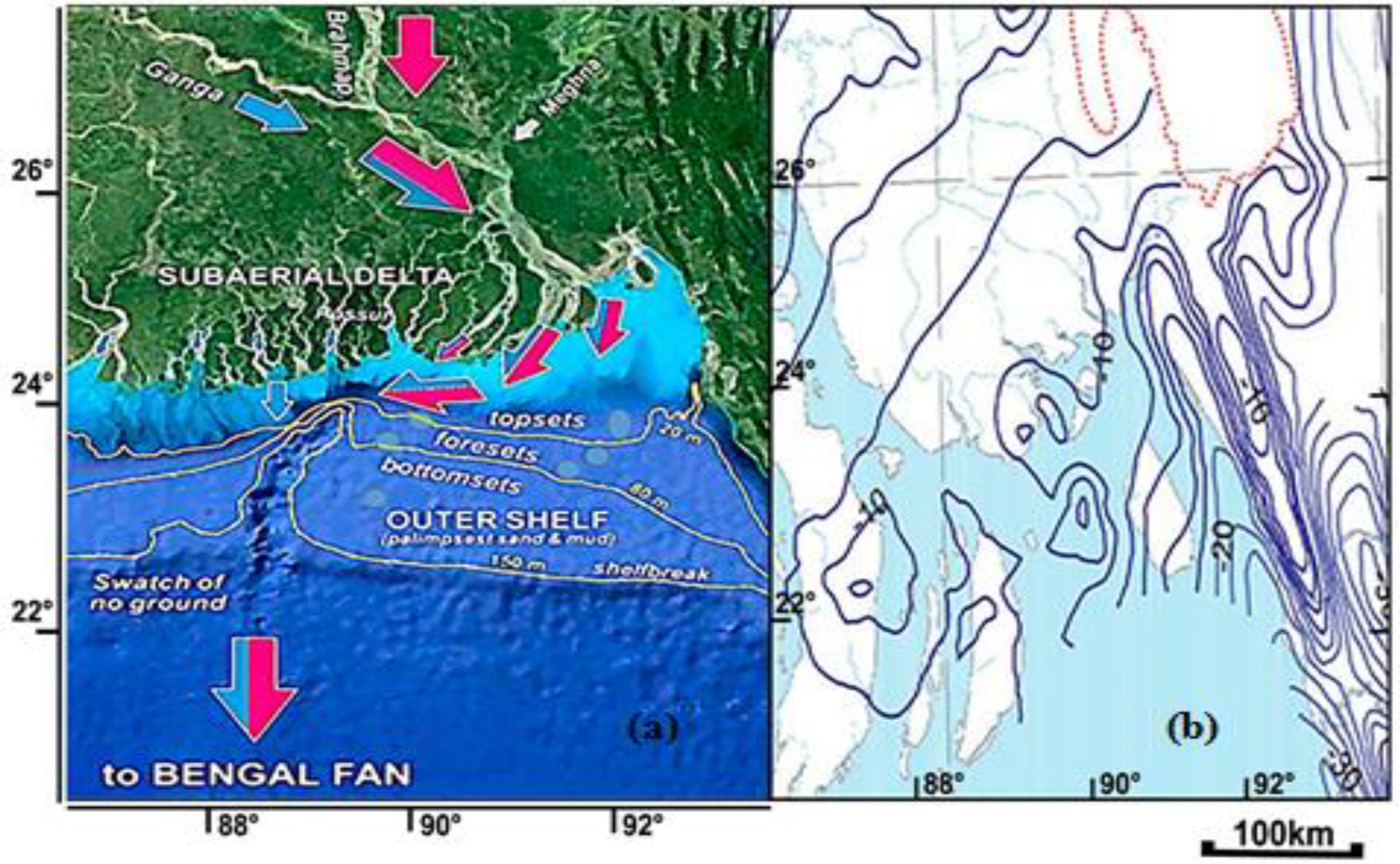
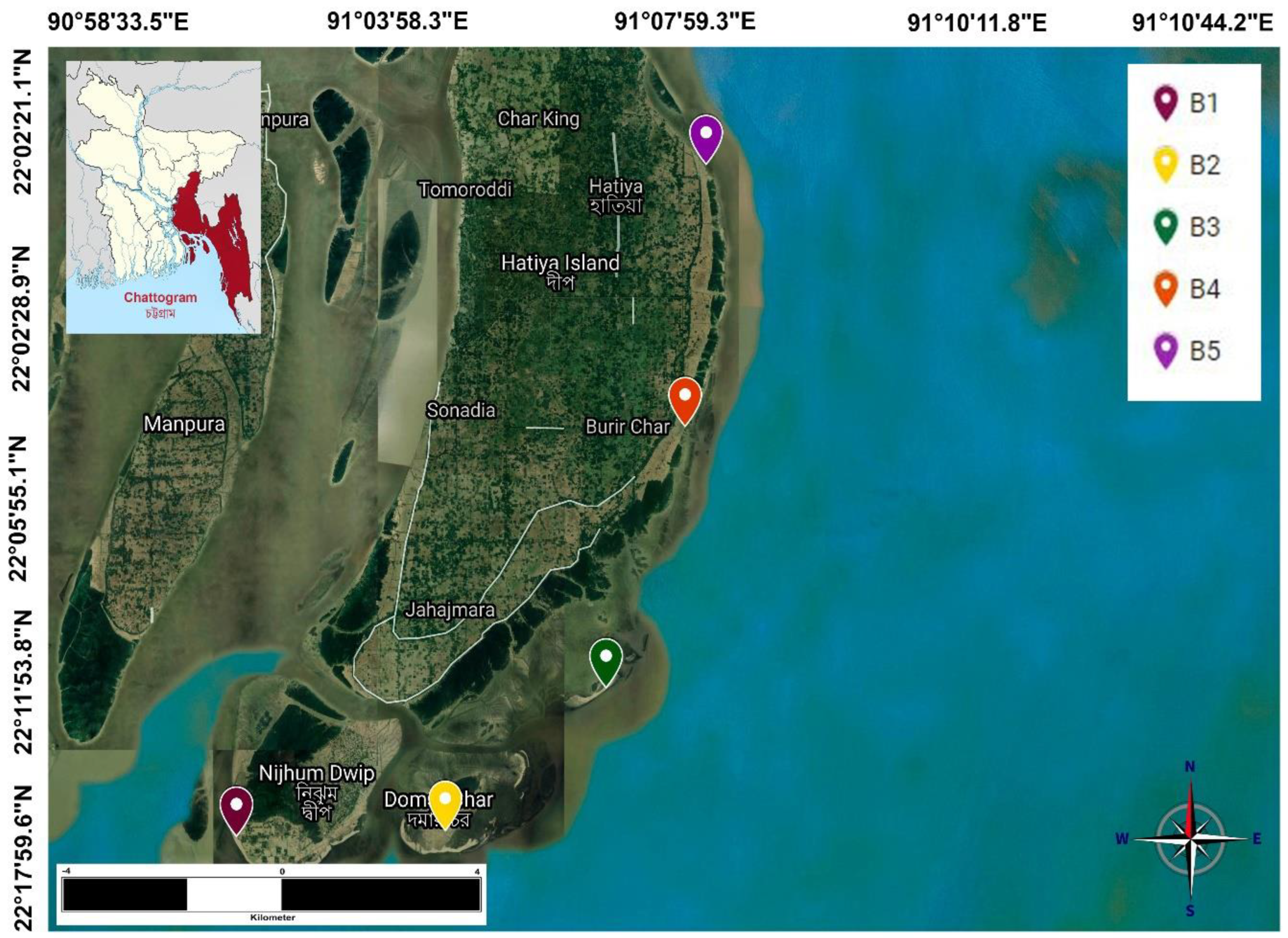

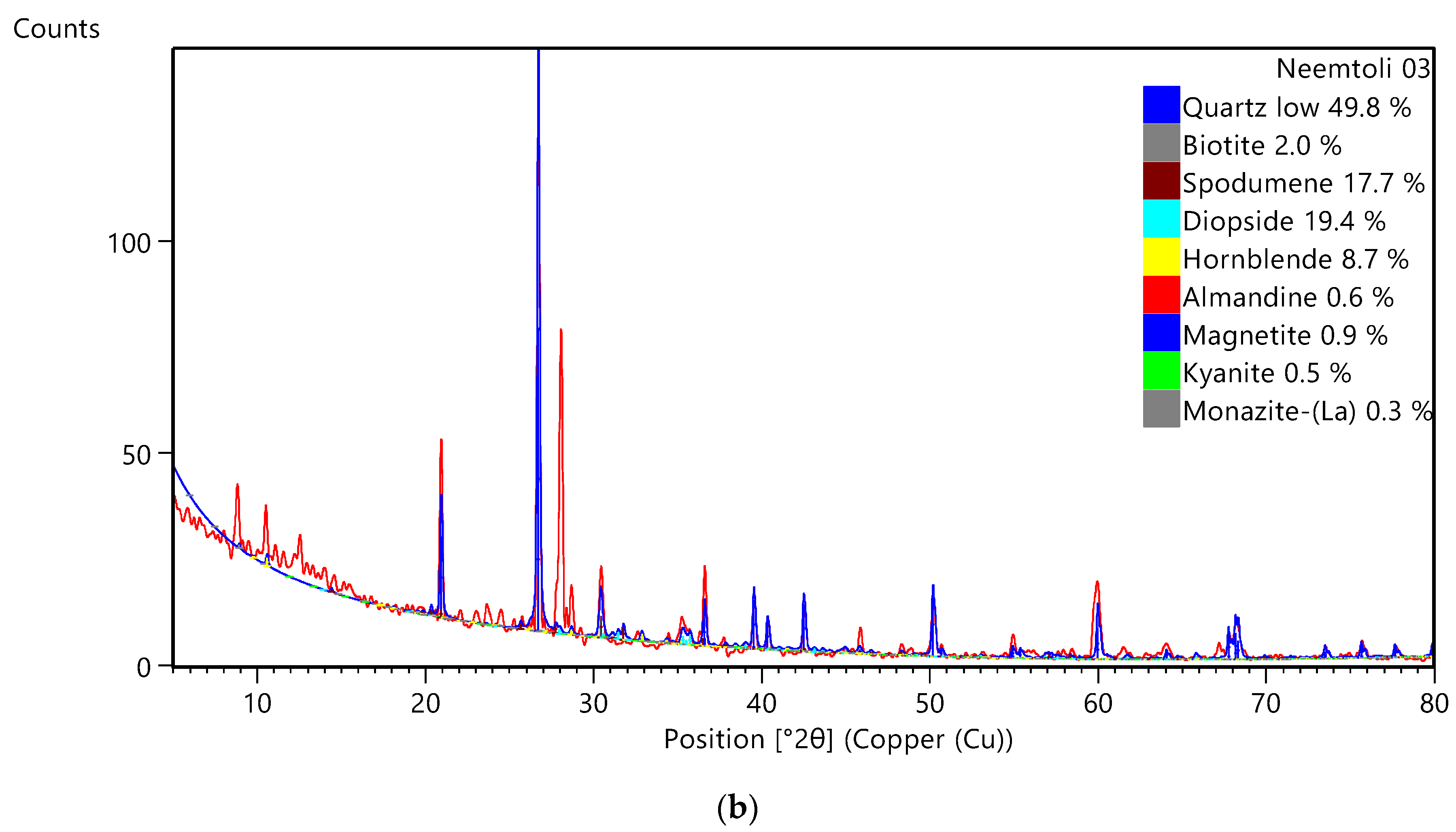
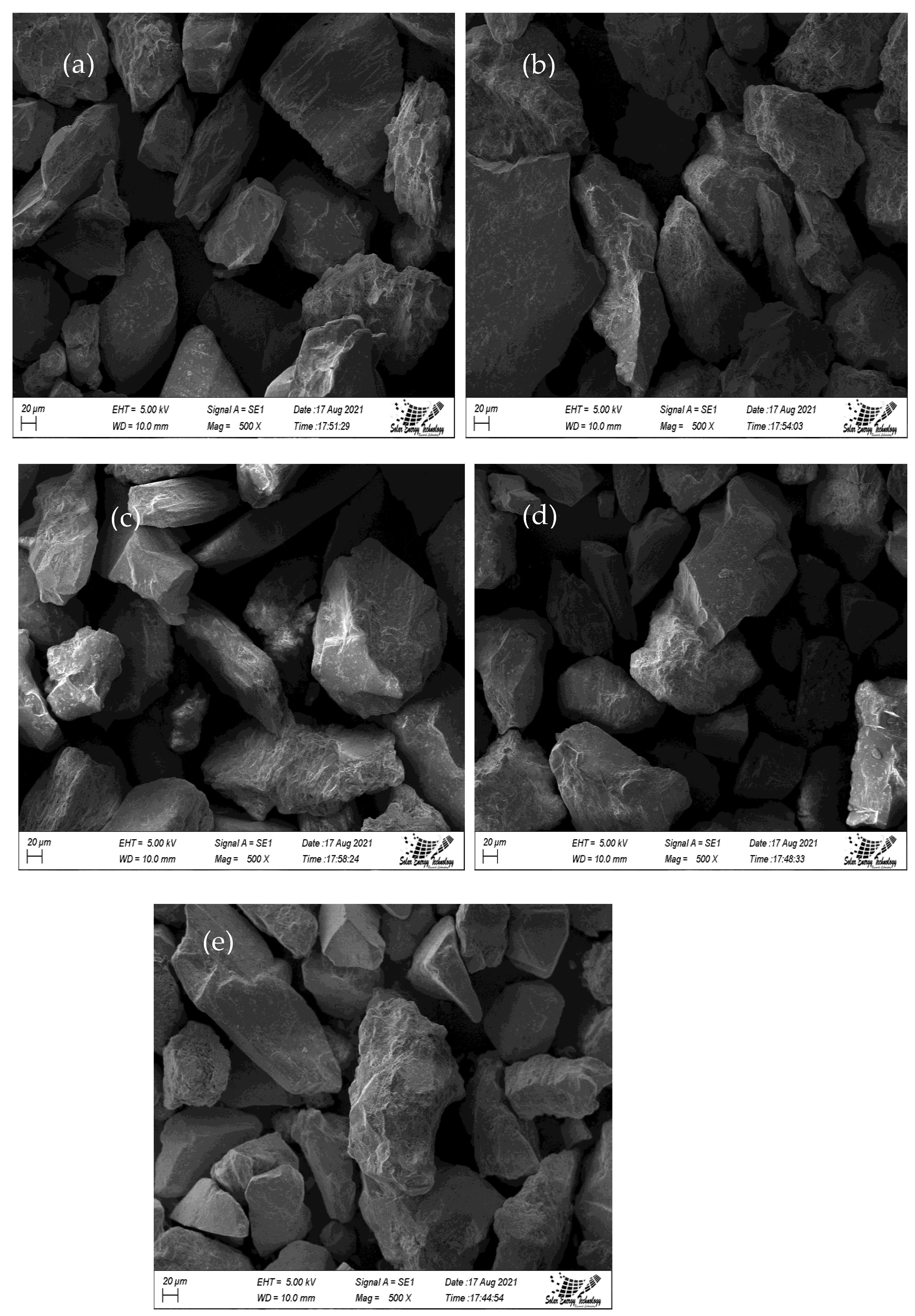

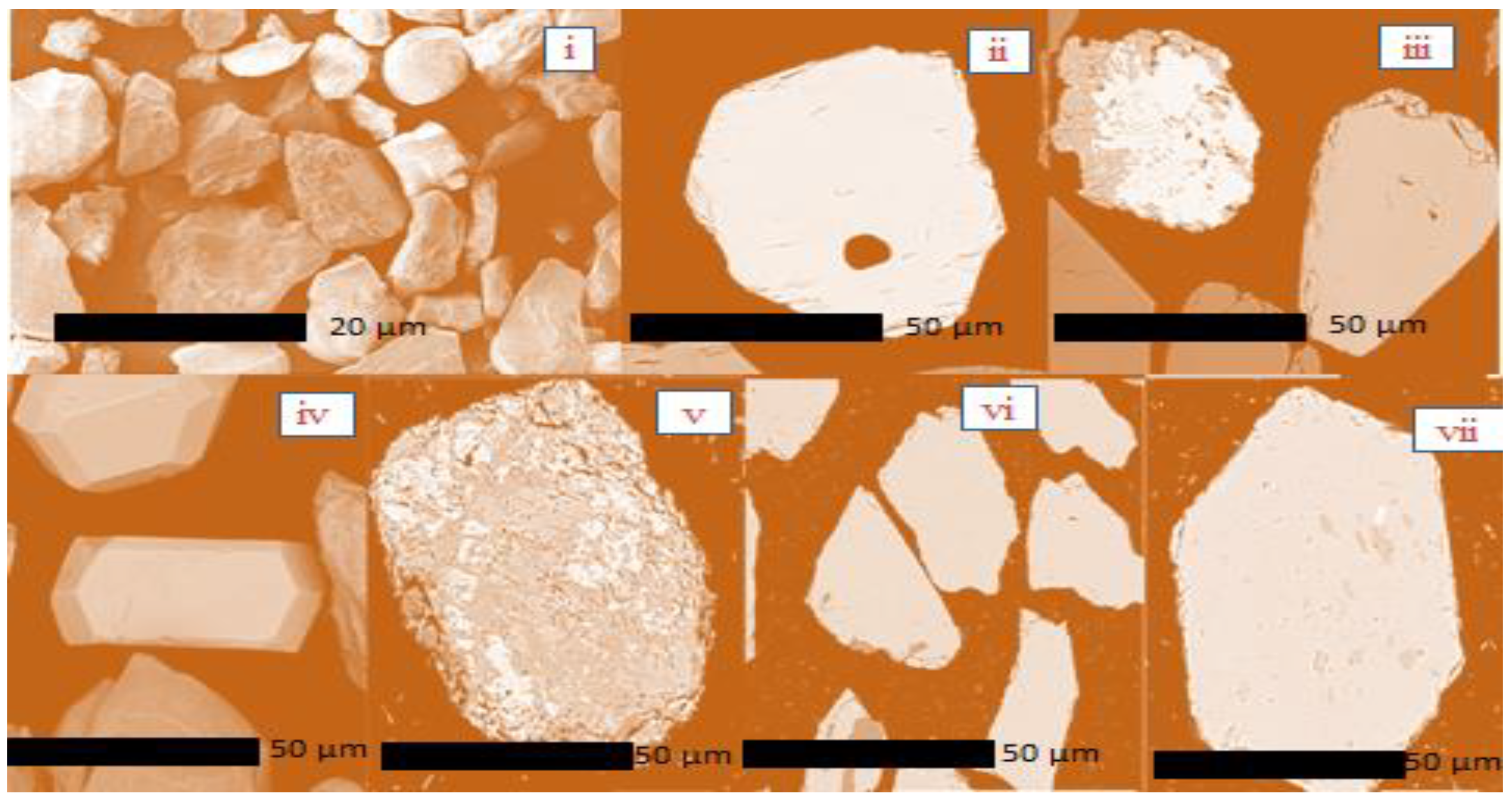


| Grain Size (µm) | Nijuhm Dwip Beach | Domar Char Beach | Nimtoli Beach | Qazir Bazar Beach | Rahmat Bazar Beach |
|---|---|---|---|---|---|
| 180–250 | 7.6 | 3.4 | 4.1 | 5.3 | 5.7 |
| 125–180 | 71.5 | 63.6 | 67.7 | 68.7 | 65.8 |
| 90–125 | 19.0 | 28.0 | 24.8 | 23.8 | 25.9 |
| 63–90 | 1.1 | 3.7 | 2.2 | 1.8 | 2.1 |
| 45–63 | 0.2 | 0.3 | 0.2 | 0.2 | 0.3 |
| Pan | 0.2 | 0.2 | 0.2 | 0.2 | 0.2 |
| Locations | Heavy (%) | Light (%) |
|---|---|---|
| Nijuhm Dwip Beach | 11.53 | 88.47 |
| Domar Char Beach | 15.46 | 84.54 |
| Nimtoli Beach | 16.12 | 83.88 |
| Qazir Bazar Beach | 16.10 | 83.9 |
| Rahmat Bazar Beach | 14.45 | 85.55 |
| Sample ID | Nijuhm Dwip Beach | Domar Char Beach | Nimtoli Beach | Qazir Bazar Beach | Rahmat Bazar Beach |
|---|---|---|---|---|---|
| Magnetite (%) | 1.65 | 2.21 | 2.1 | 2.63 | 2.46 |
| Ilmenite (%) | 2.52 | 3.38 | 3.8 | 3.2 | 3.3 |
| Rutile (%) | 2.04 | 2.73 | 2.8 | 2.62 | 2.38 |
| Zircon (%) | 2.23 | 2.99 | 3.02 | 3.1 | 2.62 |
| Garnet (%) | 2.58 | 3.46 | 3.54 | 3.39 | 2.88 |
| Total | 11.02 | 14.77 | 15.26 | 14.94 | 13.64 |
| Element Oxide | Nijuhm Dwip Beach (%) | Domar Char Beach (%) | Nimtoli Beach (%) | Qazir Bazar Beach (%) | Rahmat Bazar Beach (%) |
|---|---|---|---|---|---|
| Na2O | 1.8750 | 1.8926 | 1.9775 | 1.8892 | 1.9432 |
| MgO | 1.0458 | 1.3530 | 1.4019 | 1.4231 | 1.3241 |
| Al2O3 | 12.4931 | 11.2313 | 11.2718 | 13.2312 | 12.4352 |
| SiO2 | 73.7829 | 72.6981 | 72.8619 | 74.6754 | 73.8764 |
| K2O | 3.8309 | 2.6984 | 2.7399 | 2.9087 | 3.3246 |
| CaO | 2.0908 | 3.3745 | 3.2516 | 3.7865 | 3.3457 |
| Fe2O3 | 3.6400 | 5.0577 | 4.8818 | 5.0865 | 4.9087 |
| P2O5 | 0.0918 | 0.1561 | 0.1506 | 0.1312 | 0.1643 |
| SO3 | 0.0697 | 0.0538 | 0.1012 | 0.0601 | 0.1023 |
| Cl | 0.0845 | 0.1541 | 0.1200 | 0.1432 | 0.1210 |
| TiO2 | 0.3351 | 0.5806 | 0.6416 | 0.5708 | 0.6534 |
| V2O5 | 0.0112 | 0.0196 | 0.0127 | 0.0167 | 0.0121 |
| Cr2O3 | 0.4756 | 0.4750 | 0.3943 | 0.3869 | 0.3943 |
| MnO | 0.0488 | 0.0924 | 0.0906 | 0.1023 | 0.0839 |
| Co2O3 | 0.0008 | 0.0010 | 0.0011 | 0.0006 | 0.0009 |
| NiO | 0.0240 | 0.0147 | 0.0130 | 0.0206 | 0.0187 |
| CuO | 0.0047 | 0.0051 | 0.0060 | 0.0055 | 0.0030 |
| ZnO | 0.0046 | 0.0053 | 0.0045 | 0.0067 | 0.0034 |
| Rb2O | 0.0135 | 0.0086 | 0.0093 | 0.0089 | 0.0088 |
| SrO | 0.0253 | 0.0251 | 0.0242 | 0.0310 | 0.0190 |
| Y2O3 | 0.0088 | 0.0093 | 0.0114 | 0.0076 | 0.0213 |
| ZrO2 | 0.0118 | 0.0341 | 0.0401 | 0.0378 | 0.0475 |
| BaO | 0.0570 | 0.0596 | 0.0512 | 0.0640 | 0.0328 |
| The Estimated Percentage of Total Heavy Minerals | Name of Mineral | % of VHM | Price USD/t | Comment |
|---|---|---|---|---|
| 13.93 | Garnet | 3.17 | 75–210 | It may be a co-product. |
| Ilmenite | 3.24 | 110 | It may be a co-product. | |
| Magnetite | 2.21 | 84 | It may be a co-product. | |
| Rutile | 2.514 | 840 | It may be a co-product. | |
| Zircon | 2.792 | 1050 | It may be the main product. | |
| Micas (Light mineral) | 40.30 | 109 | It may be the main product. |
Publisher’s Note: MDPI stays neutral with regard to jurisdictional claims in published maps and institutional affiliations. |
© 2022 by the authors. Licensee MDPI, Basel, Switzerland. This article is an open access article distributed under the terms and conditions of the Creative Commons Attribution (CC BY) license (https://creativecommons.org/licenses/by/4.0/).
Share and Cite
Uddin, M.R.; Khandaker, M.U.; Akter, N.; Ahmed, M.F.; Hossain, S.M.M.; Gafur, A.; Abedin, M.J.; Rahman, M.A.; Idris, A.M. Identification and Economic Potentiality of Mineral Sands Resources of Hatiya Island, Bangladesh. Minerals 2022, 12, 1436. https://doi.org/10.3390/min12111436
Uddin MR, Khandaker MU, Akter N, Ahmed MF, Hossain SMM, Gafur A, Abedin MJ, Rahman MA, Idris AM. Identification and Economic Potentiality of Mineral Sands Resources of Hatiya Island, Bangladesh. Minerals. 2022; 12(11):1436. https://doi.org/10.3390/min12111436
Chicago/Turabian StyleUddin, Md. Ripaj, Mayeen Uddin Khandaker, Nahida Akter, Md. Farid Ahmed, Syed Md. Minhaz Hossain, Abdul Gafur, Md. Jainal Abedin, Md. Aminur Rahman, and Abubakr M. Idris. 2022. "Identification and Economic Potentiality of Mineral Sands Resources of Hatiya Island, Bangladesh" Minerals 12, no. 11: 1436. https://doi.org/10.3390/min12111436
APA StyleUddin, M. R., Khandaker, M. U., Akter, N., Ahmed, M. F., Hossain, S. M. M., Gafur, A., Abedin, M. J., Rahman, M. A., & Idris, A. M. (2022). Identification and Economic Potentiality of Mineral Sands Resources of Hatiya Island, Bangladesh. Minerals, 12(11), 1436. https://doi.org/10.3390/min12111436












